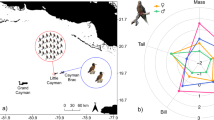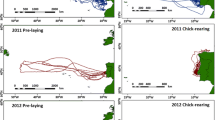Abstract
The wandering albatross (Diomedea exulans) is regarded as a generalist predator, but can it be consistent in its foraging niche at an individual level? This study tested short- and long-term consistency in the foraging niche in terms of habitat use, trophic level and, by inference, prey selection. Fieldwork was carried out at Bird Island, South Georgia, in May–October 2009, during the chick-rearing period. Blood (plasma and cells) and feathers for stable isotope analyses (δ13C and δ15N) were sampled from 35 adults on their return from a foraging trip during which they carried stomach temperature, activity and global positioning system loggers. Results suggest short-term consistency in foraging niche in relation to both oceanic water mass and trophic level, and long-term consistency in use of habitat. Consistent differences between individuals partly reflected sex-specific habitat preferences. The proportion of consistent individuals (i.e., with a narrow foraging niche) was estimated at c. 40 % for short-term habitat and trophic level (prey) preferences and 29 % for longer-term habitat preference, suggesting this is an important characteristic of this population and potentially of pelagic seabirds in general. Foraging consistency was not related to body condition or level of breeding experience; instead, it may reduce intraspecific competition.



Similar content being viewed by others
References
Anderson ORJ, Phillips RA, Shore RF, McGill RAR, McDonald RA, Bearhop S (2009) Diet, individual specialisation and breeding of brown skuas (Catharacta antarctica lonnbergi): an investigation using stable isotopes. Polar Biol 32:27–33
Araújo MS, Bolnick DI, Machado G, Giaretta AA, dos Reis SF (2007) Using d13C stable isotopes to quantify individual-level diet variation. Oecologia 152:643–654
Bearhop S, Waldron S, Votier SC, Furness RW (2002) Factors that influence assimilation rates and fractionation of nitrogen and carbon stable isotopes in avian blood and feathers. Physiol Biochem Zool 75:451–458
Bearhop S, Phillips RA, McGill R, Cherel Y, Dawson DA, Croxall JP (2006) Stable isotopes indicate sex-specific and long-term individual foraging specialisation in diving seabirds. Mar Eco Prog Ser 311:157–164
Bolnick DI, Svanbäck R, Fordyce JA, Yang LH, Davis JM, Hulsey CD, Forister ML (2003) The ecology of individuals: incidence and implications of individual specialization. Am Nat 161:1–28
Bolnick DI, Svanbäck R, Araújo MS, Persson L (2007) Comparative support for the niche variation hypothesis that more generalized populations also are more heterogeneous. Proc Natl Acad Sci USA 104:10075–10079
Bond AL, Jones IL (2009) A practical introduction to stable-isotope analysis for seabird biologists: approaches, cautions and caveats. Mar Ornithol 37:183–188
Caut S, Angulo E, Courchamp F (2009) Variation in discrimination factors (Δ15N and Δ13C): the effect of diet isotopic values and applications for diet reconstruction. J Appl Ecol 46:443–453
Cherel Y, Klages N (1998) A review of the food of albatrosses. In: Robertson G, Gales R (eds) Albatross biology and conservation. Surrey Beatty & Sons, Chipping Norton, pp 113–136
Cherel Y, Hobson KA, Hassani S (2005a) Isotopic discrimination between food and blood and feathers of captive penguins: implications for dietary studies in the wild. Physiol Biochem Zool 78:106–115
Cherel Y, Hobson KA, Weimerskirch H (2005b) Using stable isotopes to study resource acquisition and allocation in procellariiform seabirds. Oecologia 145:533–540
Cherel Y, Hobson KA, Guinet C, Vanpe C (2007) Stable isotopes document seasonal changes in trophic niches and winter foraging individual specialization in diving predators from the Southern Ocean. J Anim Ecol 76:826–836
Cook TR, Cherel Y, Tremblay Y (2006) Foraging tactics of chick-rearing Crozet shags: individuals display repetitive activity and diving patterns over time. Polar Biol 29:562–569
Dias MP, Granadeiro JP, Phillips RA, Alonso H, Catry P (2010) Breaking the routine: individual Cory’s shearwaters shift winter destinations between hemispheres and across ocean basins. Proc R Soc B 2:1786–1793
Elliott KH, Woo KJ, Gaston AJ (2009) Specialization in murres: the story of eight specialists. Waterbirds 32:491–506
Fritz H, Said S, Weimerskirch H (2003) Scale-dependent hierarchical adjustments of movement patterns in a long-range foraging seabird. Proc R Soc Lond B 270:1143–1148
Hecht T (1987) A guide to the otoliths of Southern Ocean fishes. S Afr J Antarct Res 17:2–87
Hobson KA, Clark RG (1992) Assessing avian diets using stable isotopes II: factors influencing diet-tissue fractionation. Condor 94:189–197
Hobson KA, Clark RG (1993) Turnover of δ13C in cellular and plasma reactions of blood: implications for nondestructive sampling in avian dietary studies. Auk 110:638–641
Jaeger A, Blanchard P, Richard P, Cherel Y (2009) Using carbon and nitrogen isotopic values of body feathers to infer inter- and intra-individual variations of seabird feeding ecology during moult. Mar Biol 156:1233–1240
Jaeger A, Connan M, Richard P, Cherel Y (2010a) Use of stable isotopes to quantify seasonal changes of trophic niche and levels of population and individual specialisation in seabirds. Mar Ecol Prog Ser 401:269–277
Jaeger A, Lecomte VJ, Weimerskirch H, Richard P, Cherel Y (2010b) Seabird satellite tracking validates the use of latitudinal isoscapes to depict predators’ foraging areas in the Southern Ocean. Rapid Commun Mass Spectrom 24:3456–3460
Kelly JF (2000) Stable isotopes of carbon and nitrogen in the study of avian and mammalian trophic ecology. Can J Zool 78:1–27
Lecomte VJ, Sorci G, Cornet S, Jaeger A, Faivre B, Arnoux E, Gaillard M, Trouvé C, Besson D, Chastel O, Weimerskirch H (2010) Patterns of aging in the long-lived wandering albatross. Proc Natl Acad Sci USA 107:6370–6375
Louzao M, Pinaud D, Péron C, Delord K, Wiegand T, Weimerskirch H (2010) Conserving pelagic habitats: seascape modelling of an oceanic top predator. J Appl Ecol 48:121–132
MacArthur RH, Pianka ER (1966) On optimal use of a patchy environment. Am Nat 100:603–610
Matich P, Heithaus MR, Layman CA (2010) Contrasting patterns of individual specialization and trophic coupling in two marine apex predators. J Anim Ecol 80:294–305
Newsome SD, Rio CMD, Bearhop S, Phillips DL (2006) A niche for isotopic ecology. Front Ecol Environ 5:429–436
Parnell AC, Inger R, Bearhop S, Jackson AL (2010) Source partitioning using stable isotopes: coping with too much variation. PLoS ONE 5:e9672
Passos C, Navarro J, Giudici A, González-Solís J (2010) Effects of extra mass on the pelagic behavior of a seabird. Auk 127:100–107
Phillips RA, Xavier JC, Croxall JP (2003) Effects of satellite transmitters on albatrosses and petrels. Auk 120:1082–1090
Phillips RA, Bearhop S, McGill RAR, Dawson DA (2009) Stable isotopes reveal individual variation in migration strategies and habitat preferences in a suite of seabirds during the nonbreeding period. Oecologia 160:795–806
Phillips RA, McGill RAR, Dawson DA, Bearhop S (2011) Sexual segregation in distribution, diet and trophic level of seabirds: insights from stable isotope analysis. Mar Biol 158:2199–2208
Quillfeldt P, McGill RAR, Masello JF, Weiss F, Strange IJ, Brickle P, Furness RW (2008) Stable isotope analysis reveals sexual and environmental variability and individual consistency in foraging of thin-billed prions. Mar Ecol Prog Ser 373:137–148
Rubenstein DR, Hobson KA (2004) From birds to butterflies: animal movement patterns and stable isotopes. Trends Ecol Evol 19:256–263
Schoener TW (1971) Theory of feeding strategies. Annu Rev Ecol Syst 2:369–404
Smale MJ, Watson G, Hecht T (1995) Otolith atlas of Southern African marine fishes. Ichyological monographs, vol 1. JLB Smith Institute of Ichthyology, Grahamstown
Tickell WLN (1968) The biology of the great albatrosses Diomedea exulans and Diomedea epomophora. Antarct Res Ser 12:1–55
Votier SC, Bearhop S, Witt MJ, Inger R, Thompson D, Newton J (2010) Individual responses of seabirds to commercial fisheries revealed using GPS tracking, stable isotopes and vessel monitoring systems. J Appl Ecol 47:487–497
Warburton K, Retif S, Hume D (1998) Generalists as sequential specialists: diets and prey switching in juvenile silver perch. Environ Biol Fish 51:445–454
Weimerskirch H (2007) Are seabirds foraging for unpredictable resources? Deep Sea Res Part 2 Top Stud Oceanogr 54:211–223
Weimerskirch H, Wilson RP (2000) Oceanic respite for wandering albatrosses. Nature 406:955–956
Weimerskirch H, Cherel Y, Cuénot-Chaillet F, Ridoux V (1997) Alternative foraging strategies and resource allocation by male and female wandering albatrosses. Ecology 78:2051–2063
Weimerskirch H, Gault A, Cherel Y (2005) Prey distribution and patchiness: factors in foraging success and efficiency of wandering albatrosses. Ecology 86:2611–2622
Weimerskirch H, Pinaud D, Pawlowski F, Bost CA (2007) Does prey capture induce area-restricted search? A fine-scale study using GPS in a marine predator, the wandering albatross. Am Nat 170:734–743
Weimerskirch H, Shaffer SA, Tremblay Y, Costa DP, Gadenne H, Kato A, Ropert-Coudert Y, Sato K, Aurioles D (2009) Species- and sex-specific differences in foraging behaviour and foraging zones in blue-footed and brown boobies in the Gulf of California. Mar Ecol Prog Ser 391:267–278
Williams R, McEldowney A (1990) A guide to the fish otoliths from waters off the Australian Antarctic Territory, Heard and Macquarie Island. ANARE Res Notes 75:1–173
Wilson RP, Cooper J, Plötz J (1992) Can we determine when marine endotherms feed? A case study with seabirds. J Exp Biol 167:267–275
Wilson RP, Pütz K, Grémillet D, Culik BM, Kierspel M, Regel J, Bost CA, Lage J, Cooper J (1995) Reliability of stomach temperature changes in determining feeding characteristics of seabirds. J Exp Biol 198:1115–1135
Woo KJ, Elliott KH, Davidson M, Gaston AJ, Davoren GK (2008) Individual specialization in diet by a generalist marine predator reflects specialization in foraging behaviour. J Anim Ecol 77:1082–1091
Xavier JC, Cherel Y (2009) Cephalopod beak guide for the Southern Ocean. British Antarctic Survey, Cambridge
Xavier JC, Trathan PN, Croxall JP, Wood AG, Podestá G, Rodhouse PG (2004) Foraging ecology and interactions with fisheries of wandering albatrosses (Diomedea exulans) breeding at South Georgia. Fish Oceanogr 13:324–344
Zwarts L, Hulscher JB, Koopman K, Piersma T, Zegers PM (1996) Seasonal and annual variation in body weight, nutrient stores and mortality of oystercatchers Haematopus ostralegus. Ardea 84A:327–356
Acknowledgments
This research was co-sponsored by the Foundation for Science and Technology (Portugal) through several grants (PTDC/BIA-BDE/64539/2006; SFRH/BD/64558/2009), Centre d’Etudes Biologiques de Chizé (France) and the British Antarctic Survey (UK). We thank Derren Fox, Ewan Edwards and Stacey Adlard for help in the field and G. Guillou for running stable isotope samples.
Author information
Authors and Affiliations
Corresponding author
Additional information
Communicated by C. Harrod.
Rights and permissions
About this article
Cite this article
Ceia, F.R., Phillips, R.A., Ramos, J.A. et al. Short- and long-term consistency in the foraging niche of wandering albatrosses. Mar Biol 159, 1581–1591 (2012). https://doi.org/10.1007/s00227-012-1946-1
Received:
Accepted:
Published:
Issue Date:
DOI: https://doi.org/10.1007/s00227-012-1946-1




